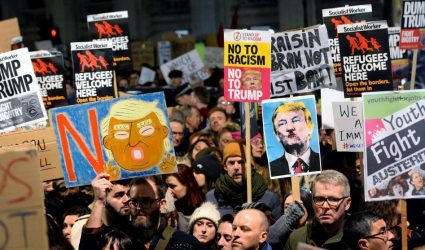Fake news and echo chambers are the virus that preys on a divided society. But what is the cure?

(SCMP) – Mass protests seem to be breaking out all over the place, from Hong Kong to Santiago, Tehran, Bolivia, Catalonia, Ecuador, France, Iraq and Lebanon. There are many local reasons for these protests, but there are common themes, such as inequality, corruption, incompetent governments, demography, social media and demand for change.
But underlying all these protests is the growing polarisation of societies, increasingly manifested in violence. Why is polarisation growing and how can deeply polarised societies heal?
Two Carnegie Endowment for International Peace scholars, Thomas Carothers and Andrew O’Donohue, have just published Democracy Divided: The Global Challenge of Political Polarisation, which examines these vexing questions.
In a study of Bangladesh, Brazil, Colombia, India, Indonesia, Kenya, Poland, Turkey and the United States, they attribute populism to the rise of decisive leaders who push nationalism, demonise opponents and stir up issues that further divide societies. “Amplifying the effect of these divisive figures is the technologically fuelled disruption of the media industry, especially the rise of social media,” the authors said.
The authors think that polarisation in the US is particularly deep and sharp because it combines what they call the “iron triangle” of ethnicity, ideology and religion. Increasingly, partisan politics remove the bonding power of centrist or moderate forces. Too often, this creates gridlock in the legislature, diluting public trust in its efficacy and pushing decision-making increasingly to the executive branch.

In more and more elections, from Recep Tayyip Erdogan to Donald Trump, charismatic leaders win elections at the expense of polarising society.
Forty years ago, most societies would have 60 per cent of people in the centrist or moderate group, with 20 per cent each on the left or right side of political or social views. Today’s polarisation has shifted 40 per cent each to the left or right, with only 20 per cent in the middle, which may swing either way depending on the mood of the moment.
Thus in the recent Hong Kong district elections, the pro-democrats won 55 per cent of the votes, but took most of the seats due to the rule of simple majority. Another 41 per cent voted for the Hong Kong government, not unlike the 40 per cent approval rating that Donald Trump has roughly averaged in his term of office, despite repeated attacks by the Democrats.
The generation divide also comes into play. Having more experience of the consequences of social disorder, the older generations tend to prefer the status quo. Lacking that experience and knowledge, the younger generations want change now and some are willing to be violent to make dramatic changes.
Disrupters have discovered that you can turbocharge social polarisation through technology by disseminating bad or fake information. The underlying public discontent with globalisation, loss of jobs, fear of migration, social inequality, incompetent or corrupt governance is the dry prairie that needs only the spark of fake or false information to be set ablaze.
In 2017, the Council of Europe report on information disorder classified the malaise into three categories: misinformation, when false information is shared, but no harm is meant; disinformation, when false information is knowingly shared to cause harm; and mal-information, when genuine information is shared to cause harm, often by moving private information into the public sphere (trolling or doxxing). Information disorder is very disruptive, because bad information with ill-intentions can be produced and pushed at minimal costs.
The world is therefore suffering from “severe information disorder syndrome” (Sids), a viral attack not dissimilar to the 2003 severe acute respiratory syndrome outbreak. Freedom of information on the internet has allowed fake news to target vulnerable groups such as schoolchildren, through computational amplification (artificial intelligence manipulation of online views), filter bubbles and echo chambers that reinforce prejudices, eroding trust in evidence, institutions and truth.
It is bad enough that criminals, terrorists and fundamentalists are using social media to promote crime and discontent. It is worse when governments involved in geopolitical rivalry use social media to disrupt each other, such as cold war dissemination campaigns. Information viral attacks against each other create such fears that there is already talk of the splinternet – Balkanisation of the internet through national firewalls.
As Carothers and O’Donohue recognise, what makes Sids intractable is that severe polarisation damages all institutions essential to democracy, such as the police or judiciary. Polarisation poisons everyday interactions and relationships, dividing families, fellow workers and civil society, contributing to spikes in hate crimes and political violence. Worse, once society is deeply divided, it is very difficult to heal.
Governments cannot respond to divided societies with the speed and clarity which the public expects, precisely because there are no simple answers. Worse, freedom of information guarantees that neither the government, judiciary nor legislature can easily stop fake news, because it is difficult and costly to prove and punish.
In short, as long as fake news and echo chambers exist, there is no good way to counter the effects of Sids. Even Google
is not immune to biases and echo chambers.
If these global tech platforms have hidden algorithms that perpetuate hate and polarisation, what can governments do about this? Last year, after the “yellow vest” protests erupted, French President Emmanuel Macron proposed a Paris Call for Trust and Security in Cyberspace, supported by 75 countries and companies such as Microsoft and Huawei.
Unfortunately, key players such as the US, China, India, Brazil and Russia have not signed on.
We are therefore still far from addressing Sids viral attacks. We need not only cyberspace hygiene to prevent an information viral outbreak, but also global cooperation to regulate technology platforms and set up clear cyberspace rules. As long as the world is globally and locally polarised, expect more mass protests through vicious Sids outbreaks.
Has fake news, spread by social media, led to the riots we see today? If so, has free speech failed?

